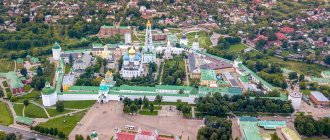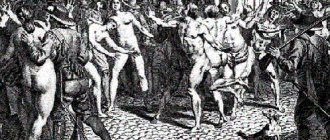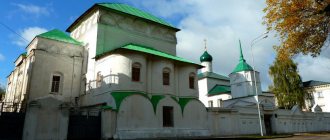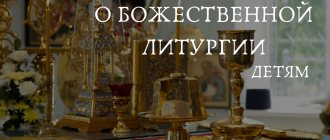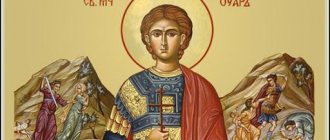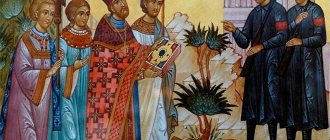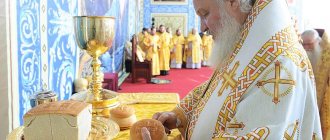Rod of Salvation, Rod of Righteousness
According to TASS on September 22, Patriarch Kirill of Moscow and All Rus' forbade governors and abbots of monasteries to have expensive staffs and called for ordering simple wooden staffs instead. At the Meeting of Abbots and Abbess, held in Moscow in honor of the 1000th anniversary of the Russian presence on Mount Athos, the Patriarch said: “Each abbot is given a staff as a symbol of spiritual power. I was the initiator for the abbots and abbess to receive staffs, but it didn’t even occur to me that our abbots and abbess would turn these staffs into patriarchal staffs: they would richly decorate them and put up a cross. I do not bless such rods.” Addressing the governors and abbots of the monasteries gathered in the Cathedral of Christ the Savior, the patriarch said: “You should have a simple abbot’s staff without any decorations, without any jewelry trinkets and without a cross - this is a symbol of the bishop’s service.” “Therefore, when you arrive at your home now, the first thing you will do is order yourself simple wooden staves” (see: https://tass.ru/obschestvo/3643672).
What can I say? The Patriarch was outraged not only by the precious decoration of the rods, but also by the fact that they were turning into “patriarchal rods.”
In other words, only the patriarch can have something expensive and decorated? But he knows firsthand that the staff of St. Metropolitan Peter of Moscow was quite simple. Indeed, in 2009, one of the moments of the enthronement ceremony of Patriarch Kirill was the presentation of the staff of St. Peter to him. Let us remember that this staff was made by Russian craftsmen at the beginning of the 14th century from ebony. The shaft of the staff is octagonal in shape, the handle is framed with gilded silver, the rings that span the entire length of the shaft have modest decoration. On both sides of the shaft, gilded plates with carved images of Golgotha descend from the handle. At the top of the staff is the inscription: “Humble Peter, Metropolitan of All Rus'.” That, in fact, is all the “decoration”.
However, few people pay attention to the fact that it is not so much the rich or poor decoration that matters, but the symbolism embedded in the wand. But the symbolism now used in modern staves is very different and at times raises serious questions.
In the famous essay “Pomeranian Answers” there is a separate chapter “On the Bishop’s Rod ,” which provides a comparison of the old Russian and new, post-reform rods. Supporters of the old faith immediately drew attention to the fact that there was a total change not only in the verbal forms of the Christian faith, but also the objects of the material culture of the Russian Church, consecrated by not just one century, and not just one, but a whole host of saints, were being distorted. The authors of the essay point out that the staffs of the “Old Russian” bishops “do not have serpentine heads on them.”
Photos from the popular print of the Bespopovtsy publication “Before and Now.” Published: Collection of the people's newspaper. 1906. Colored miniatures from the illustrated collection “Tales from Various Divine Scriptures.” Contains individual sayings from the books of the Old and New Testaments with interpretations of them by John Chrysostom and Hippolytus, Pope of Rome. 19th century Collection from the Egorov collection, NIOR RSL
"Liturgical objects and bishop's vestments: Old Believer and Nikonian." NIOR RSL F. 98 (collection of E.E. Egorov) No. 1670. Sheets 25 and 40
As an authoritative example, the rods of Metropolitan Peter, the Moscow miracle worker, and Bishop Nikita, the Novgorod miracle worker, are given.
On the left is the staff of Bishop Nikita of Novgorod. Wood, carving, bone. 16th century On the right is the staff of St. Stephen, Bishop of Perm
The chapter indicates a modification of the shape of the ancient staff, the handles of which have an end in the form of an anchor: “on the side it has hooks like anchors, but does not have serpentine heads.” The rod with a handle in the form of an anchor is interpreted by the authors according to the words of Simeon of Thessaloniki : “power signifies the Spirit, and the affirmative of the people, and the pastoral, and to lead the relics, and to punish the disobedient, and to turn those who are distant to oneself.” From a simple shepherd's staff, symbolizing the bishop's power and the duty to shepherd the verbal sheep, thanks to Patriarch Nikon, it turned into a staff with pagan symbols in the form of snakes, which in the 17th century were interpreted by many as a manifestation of the power of the Antichrist.
Now is the 21st century, so let’s try to look at the problem of the symbolism of the rod through the eyes of a modern person. At the same time, I will make a reservation that what is stated below is only one of the possible versions of the interpretation of the symbolism that appeared after the church reform. Yu. M. Lotman, a famous researcher in the field of semiotics (the science of symbols in culture), wrote: “a symbol never belongs to any one synchronous section of culture - it always pierces this section vertically, coming from the past and going into the future. The memory of a symbol is always older than the memory of its non-symbolic textual surroundings.” An article by K. A. Shchedrina in the Stavrographic Collection is devoted to the symbolism of the bishop’s staff. [1]
The author rightly notes that before the reform of Patriarch Nikon, the pommels of Russian bishop's staffs traditionally consisted of two spurs curved downwards. [2] However, then Shchedrina immediately moves on to the pommel with snakes, without giving an explanation of the symbolism of pre-reform staves.
"Bishop vestments: Old Believer and Nikonian." NIOR RSL F. 98 (collection of E.E. Egorov) No. 1670. Sheets 75 and 77
Going through the types of crosses (Athos, Ethiopian, Armenian), K. A. Shchedrina only at the end of the article mentions the serpentine rod of the god Hermes - the caduceus. It is from the caduceus that we will start in our discussions, as from the original symbol that gave rise to the symbolism of the bishop’s staff of the 17th and subsequent post-reform centuries.
But first, a short historical excursion into the field of symbolism. In the Mesopotamian tradition, entwined snakes were considered the embodiment of a healing god (perhaps this is where the biblical image of the copper serpent healing snake bites comes from).
In the Asia Minor tradition, two snakes were a symbol of fertility. The prototype of the caduceus could also be the image of two snakes near the world tree. In India, the caduceus symbolizes the awakening of kundalini. Kundalini, or Snake Fire, “sleeps” in the base chakra in the form of a coiled snake, and when it wakes up as a result of evolution, it ascends along the spine along three paths: the central one, Sushumna, and two lateral ones, which form two intersecting spirals, Pingala (this is the right, male and active spiral) and Ide (left, female and passive). The Scandinavians worshiped Hermes under the name of Odin, the Teutons under the name of Wotan. The good and evil principles of ancient Persia - Ahuramazda and Ahriman were sometimes depicted in the form of two snakes, their heads facing each other, fighting for the Egg of the Earth, trying to snatch it from someone else's teeth.
In the world of images of alchemy, both snakes symbolize the chemical elements sulfur (Sulfur) and mercury (Mercurius) in balance, that is, they are perceived as a dual system of the principles of fluidity and flammability, and mercury was personified by the god Mercury himself. [3] The Egyptians likened humanity to a flock of sheep. The Supreme and Incomprehensible Father was the Shepherd, and Hermes was his shepherd, his watchdog. The religious and symbolic origin of the shepherd's stick can be found in Egyptian rituals: the three scepters of Egypt include a shepherd's stick, symbolizing the power with which the initiated pharaoh decides the destinies of his people. So, the caduceus is a symbol of the god Mercury or the Greek Hermes, the herald of the gods. It consists of a magical or heraldic rod around which two snakes with their heads facing each other are coiled symmetrically.
In the light of the later understanding of Hermes as the personification of thinking, snakes become a symbol of wisdom, the rod - an image of power over the forces of nature. The name Hermes is derived from the word "herm", a form of Hiram, the personification of the Universal Life Principle, or the Life Principle represented by fire. Considering the deep symbolism of the Mercury-Hermes rod, we come across two concepts - dualism and dialectics. Plato in the dialogues “Sophist” and “Parmenides” substantiates the dialectical conclusions that the highest kinds of existence can only be thought of in such a way that each of them is and is not, equal to itself and not equal, identical to itself and passes into its “other” " The medieval thinker G. Böckler (1688) noted that some equate the staff of Hermes with Dialectics, which allegedly decided with confused heads what was righteous and what was not. Dualism teaches that material and spiritual substances are equal principles. To put it extremely simply, the staff of Hermes asserts the equality between Good and Evil.
History knows many Gnostic sects that speculated on Christianity and sowed their poisonous tares into it. In this regard, the Gnostic sect of the “ophites”, which means “serpentine”, is of interest. Information about the same Christian sect has reached us under the name “Naassenes” (Hebrew “nachash” - snake). Another name for them is “setians”. They were joined by “Cainites” and “Peratics”. Several Ophite texts are believed to have been found in the Nag Hammadi library. The Ophites revered Christ as a serpentine incarnation, worshiped him as the “Good Serpent,” who personified wisdom and gave people true knowledge, and believed in the plurality of his incarnations. Along with this, the Ophites taught about other snakes hostile to the human race. By the way, Ophite gnosis was especially widespread in Egypt.
As we see, in the bishop’s staff with two snakes, the influence of Gnostic teachings can be traced, according to which, if we take the symbolism of the reformers of the 17th century to its logical conclusion, equality between Christ and Antichrist is affirmed. Categorically? But otherwise it is difficult to understand why such a symbol was imposed on a person of ancient Russian culture. After all, the meaning of the snake in the medieval consciousness is clearly negative: God cursed the snake, which became an instrument of the devil. Summarizing what has been said, let us ask ourselves the question: is it worth being indignant about the expensive decoration of the bishop’s staffs, when in the hands of the bishops (and abbots) there is such an ancient symbol that it is scary to look at? Yes, according to the words of Archpriest Avvakum, the snake “was a good beast, red, and had not stolen anything yet.” But she stole it?..
[1]. Shchedrina K. A. Two snakes on the bishop’s staff of the 17th century: notes on origin and symbolism // Staurographic collection. Book III: The Cross as a Personal Shrine. Sat. articles. M.: Publishing House of the Moscow Patriarchate; Publishing house "Drevlekhranilishche", 2005. [2]. Right there. P. 315. [3]. Encyclopedic Dictionary of Symbols/Auth.-comp. N. A. Istomina. M.: AST Publishing House LLC: Astrel Publishing House LLC, 2003. p. 334-335.
Notes on the symbolism and history of church utensils. Bishop's staff
The pommel of the staff of St. Peter Metropolitan of Moscow
The liturgical routine of the Orthodox Church has been formed over thousands of years, absorbing meanings, symbols and images from different eras and cultures. A bouquet of spiritual aromas that has no equal on earth combines the simplicity and heroism of the first centuries of Christianity, the exquisite solemnity of Byzantium, the strict prayerful joy of Ancient Rus'...
Whatever item of liturgical utensil we look at, it will tell us more than one story. Many of these objects carry images that are archetypal, common to cultures that are very distant from each other. A crown is a sign of triumph and victory. The bowl is a symbol of unity and at the same time - fate. The staff is an attribute of strength and power.
The bishop's staff is a shepherd's staff, an anchor, a control tool, and a weapon of defense... It is a burden of duty and a support on the way, a measure that does not allow one to go astray, and a sign of spiritual wisdom. This image contains the idea of power as the ability to stand firmly on your feet, follow the right path and lead followers, drive away and defeat opponents.
In ancient images of Christ the Good Shepherd, we see in the hands of the Savior a shepherd’s staff with a rounded handle. Most likely, the apostles also carried out their preaching journeys with staves in their hands. And, probably, even then a symbolic parallel of these staves with the rod of the Old Testament high priest arose.
“Apple” - thickening on the staff
Nowadays, the Russian Orthodox Church has developed a traditional form of the bishop's staff, which has several main variations. The upper part of the bishop's staff, used during divine services, is certainly topped with a cross mounted on a spherical “apple.” This “apple” with a cross distinguishes the attribute of the episcopal rank from the staff used by the abbots of monasteries. The staff of the wand, as a rule, is also decorated with rounded thickenings - “apples” or flat bridges - “rims”. During non-liturgical times, the bishop uses a simple-shaped staff, the handle of which does not have a crossbar. As a rule, wands are made of wood, most often dark. Liturgical (and sometimes everyday) bishop's staffs are decorated with handles and plates made of metal, most often made of silver.
Today, three main forms of the liturgical bishop's staff are used. The most ancient of them are with a T-shaped handle and with a handle, the ends of which are slightly rounded and lowered down. These forms probably came to Rus' from Byzantium. The most impressive form is the staff, the ends of the handle of which grow into images of snakes raising their heads. It appeared in Russia in the 17th century.
During the enthronement of His Holiness the Patriarch of Moscow, he is solemnly presented with the staff of St. Peter, Metropolitan of Moscow - as a sign of the continuity of spiritual power. Saint Peter played a key role in the formation of the Moscow principality: it was he who predicted the rise of Moscow to Grand Duke John Kalita, blessed the construction of the stone Assumption Cathedral in the Kremlin, and transferred the metropolitan see from Vladimir to Moscow. The saint's staff is a significant relic of the Orthodox Church. This octagonal wand, carved from dark wood, is decorated with a silver-gilded handle with slightly rounded ends. Let us note that the staff of St. Peter, made in the 14th century, does not have a cross crowning it. But from its handle to the shaft descend plates with the Calvary Cross and the instruments of the Passion of Christ carved in silver. This image eloquently speaks of the significance of the bishop’s service as bearing the cross and at the same time reminds us that the bishop carries out his service according to the grace given to him by Christ. The rounded ends of the handle represent an anchor - one of the key images of Christian symbolism, a sign of firmness in faith and spiritual prudence.
Staff of St. Stephen of Great Perm
The bishop's staff of St. Stephen of Perm, who, like St. Peter, lived in the 14th century, also has a form similar to the staff of St. Peter. Saint Stephen, a missionary who converted half-wild Perm Zyryans to the Orthodox faith, walked with a simple staff, which he personally made from light larch. Through the prayers of the saint, this staff became miraculous: with its touch Saint Stephen destroyed the idolatry. In this hagiography we see another symbolic meaning of the bishop’s staff - as a spiritual weapon, an instrument through which Divine grace acts. How can one not recall here the ancient prophet Moses, who, by the will of God, brought water out of a stone and divided the thickness of sea water in two with the touch of a staff. The fact that these actions are carried out not just with a hand, but with a rod, contains a spiritual meaning: the messengers of God act not on their own, but by the power that was given to them from above along with the call to serve.
After the death of Saint Stephen, his staff stood near the tomb of its owner, who was buried in Moscow, in the Church of the Savior on Bor. As a sign of reverence for the saint, the staff was decorated with finely crafted elk antler carvings depicting scenes from his life. In 1612, the relic was taken away by the Poles who occupied the Russian land. But the Lord preserved the shrine and more than two hundred years later - in 1849 - it was accidentally discovered in one of the churches in Lithuania, identified by a Church Slavonic inscription and returned to the Fatherland. The staff was transferred to Perm, where it was placed in the cathedral. There he enjoyed popular veneration until 1918, when the shrine was requisitioned by the Soviet government. Nowadays, the staff is in the Perm Museum of Local Lore, from where it is sometimes taken out for worship by believers.
Staff of St. Dimitry of Rostov
The staff of St. Demetrius of Rostov, who lived in the 17th – early 18th centuries, is similar in shape to the staffs of St. Peter and Stephen. But there is one difference: a small cross mounted on the pommel. Thus, this staff has the same shape as those used by modern bishops. Decorated with small enamel “grass” patterns on a dark brown background, the staff is strict and picturesque at the same time.
The bishop's staff, associated with the name of St. Nikita of Novgorod, who died at the beginning of the 12th century, but attributed by researchers to the 15th or 16th centuries, had a slightly different form, which also became a prototype for the works of modern masters. This staff was kept for several centuries in the sacristy of the St. Sophia Cathedral in Veliky Novgorod, now in the Novgorod State Historical and Architectural Museum-Reserve. The handle of the staff is bone, strictly T-shaped, and so wide that the master managed to divide it into rectangular “cases”, in each of which relief images of saints are carved. The crossbar of the handle becomes a miniature resemblance to the Deesis row of the iconostasis: in the center is the image of the Savior, on either side are the Most Holy Theotokos and John the Baptist, then the archangels and saints. Icon images and the upper part of the vertical part of the staff were decorated. The master or several masters who created this work of ancient Russian small sculpture carved images of the holy princes Boris, Gleb and Vladimir, the Venerable Anthony the Great, Savva the Sanctified and Sergius of Radonezh, the martyrs Theodore Tiron and Theodore Stratelates, Saints Peter of Moscow, Leonty of Rostov and many other saints of God who labored in Rus' far beyond its borders. Researchers, in particular A.V. Chernetsov, note the similarity of the compositional and iconographic design of the miniatures decorating the staff with the murals of the Cathedral of St. Sophia of Novgorod, created at the turn of the 15th and 16th centuries. The staff of St. Nikita, very original and decorative, became the prototype for the works of some modern masters. Moreover, while the original was made of bone, the wands now created based on its motives are often made of silver.
Patriarch Nikon
The 17th century became a time of spiritual upheaval for Rus'. The reforms of Patriarch Nikon, who sought to correct inaccuracies in worship, aroused violent opposition from part of the clergy and laity, which, as we know, ended in a tragic split in the Russian Church and society. One of the stumbling blocks was the shape of the pommel of the bishop's staff. Patriarch Nikon began to use a rod with an end in the form of two snakes looking at each other. Between the snakes there is a cross mounted on an apple. Opponents did not fail to see in this artistic decision one of the proofs of Nikon’s anti-Christianity. Meanwhile, this form was by no means invented by the powerful Moscow Patriarch. It was used in Greece, where it did not cause any criticism or surprise. (Remember that in Greece, much larger images of snakes are common, crowning iconostases). Without attempting to judge whether it was worth introducing into Rus' an image so revolutionary for the mentality of its inhabitants, we note that the image of snakes on the staff is by no means accidental and is full of deep symbolism. First of all, they remind us of the miracle of Moses, who turned his own staff into a snake and then returned it to its original appearance. Then, they bring to mind the copper serpent made by the same Moses. According to the testimony of the Old Testament, looking with faith at this serpent mounted on a high pillar, the ancient Jews were called to save themselves from the punishment that befell them for sin - death from snake bites. The image of the copper serpent contains a prediction about the Savior’s Sacrifice on the Cross, therefore in this context the serpent becomes a symbol of Christ Himself. Of course, the snakes on the attribute of the bishop’s service also remind us of the words of the Savior: “Be wise as serpents and pure as doves.”
Finally, it can be assumed that the snakes on the bishop's staff became an artistic development of a lush floral ornament in the form of a vine - and the “flourishing staff,” as follows from the Old Testament, is a sign of spiritual power given by God. It was by such a miracle as a dry staff that grew flowers and leaves that God revealed the election of ancient Aaron to the high priestly service. The flourished, that is, decorated with floral ornaments, the rod also reminds us of the heavenly Tree of Life - thus conveying to us the idea of the salvation of the Sacraments of the Church, performed through the ministry of the bishop. Finally, this image speaks of the prophecy of Isaiah, in which, under the image of “the rod from the root of Jesse, which brought forth fruit,” it speaks of the Most Holy Theotokos.
Alina Sergeychuk
What is the staff for?
| To contents | To previous page | To next page |A reader asks
During his enthronement, Patriarch Kirill was presented with a staff. Please tell me what this item means and what it is needed for? Margarita Smekhova, Tambov
THE BISHOP'S ROD is a sign of the bishop's archpastoral authority over the church people, similar to that which a shepherd has over a flock of sheep. The rod (staff) personifies wandering, preaching, shepherding as a symbol of wise leadership.
The bishop's staff is a staff with a hilt. In ancient times, the purpose of the staff was quite specific: it was taken with you on the road when it was necessary to cover a long distance on foot. Both shepherds and monks used such staves. The long staff not only made it easier to climb the mountain, but also helped to drive the sheep.
One of the main symbols of early Christianity is the shepherd, that is, the shepherd. He shepherds, knows and loves his sheep, takes care of them, and therefore the flock obeys him. In ancient times, Christ was often depicted as a Shepherd with a staff, carrying a lost sheep on his shoulders. Therefore, both priestly and episcopal ministry are called pastoral. Perhaps the disciples of Christ, the Apostles, who were called to preach throughout the world the joyful news of the Son of God, also used staves. The bishop's rod, or staff, thus, on the one hand, embodies the idea of pilgrimage, preaching, and on the other, is a symbol of shepherding, wise leadership and power.
The crozier is given to each bishop at his consecration. It was handed over to the Byzantine Patriarch by the emperor himself. At first, the shape of the bishop's staff was similar to a shepherd's staff - with a curved upper part. Then staves appeared with an upper crossbar, the ends of which were slightly curved down, which made them look like an anchor. The fact is that another very common symbol of Christianity is a ship. It means the Church, which in the world is like a reliable ship, with whose help we can sail across the troubled sea of our lives. The anchor of this ship is hope in God.
Since ancient times, the staff that the bishop uses during worship has been decorated with precious stones, patterns, and inlays. The daily staffs of bishops are much more modest. Typically these are long wooden sticks with a head made of carved bone, wood, silver or other metal. This difference exists because, according to canonical rules, bishops and other clergy are prohibited from decorating themselves with expensive and bright clothes and objects in everyday life.
Solemnity and pomp are appropriate only during divine services. A special feature of Russian bishop's staffs is the sulok - two scarves inserted into one another and tied to the staff at the top crossbar of the handle. Sulok arose due to Russian frosts, during which religious processions had to be performed. The lower scarf was supposed to protect the hand from touching the cold metal of the rod, and the upper one was supposed to protect it from external cold.
There is an opinion that reverence for the shrine of this symbolic object prompted the Russian hierarchs not to touch it with their bare hands, so that the sulok can also be considered a sign of God's grace covering the human weaknesses of the bishop in the great matter of governing the Church and in the use of God-given power over it.
Today, a rod without a sulka is the exclusive privilege of the Patriarch. Also a feature of the Patriarchal service is the right of the Patriarch to enter the altar with a rod through the Royal Doors, while other bishops, entering the altar, give the rod to the subdeacon, who holds it in his hands, standing to the right of the Royal Gates.
One of the main shrines of the Russian Church, the symbol of the Russian high priests is the staff of Metropolitan Peter. The wooden staff of Metropolitan Peter (14th century) is kept as a museum exhibit in the Armory Chamber of the Moscow Kremlin. It is an indispensable attribute of the enthronement of the primates of the Russian Orthodox Church. Twice this rarity was handed over from the Armory into the hands of Patriarch Alexy II of Moscow and All Rus' - on the day of his enthronement on June 10, 1990 and at the service on the occasion of his 70th birthday.
Source: Ria-Novosti (rian.ru/p_spravki/20090127/160228719.html)
| To contents | To previous page | To next page |
God bless you!
All rights to materials located on the VZOV.RU website are protected in accordance with the legislation of the Russian Federation, including copyright and related rights. For any use of site materials and satellite projects, a hyperlink to VZOV.RU is required.
Newspaper editorial office email address
| ©VZOV.RU, 2001—2013 |
Bishop's staff or staff. Reference
The bishop's rod, or staff, thus, on the one hand, embodies the idea of pilgrimage, preaching, and on the other, is a symbol of shepherding, wise leadership and power.
The crozier is given to each bishop at his consecration. It was handed over to the Byzantine patriarch by the emperor himself. At first, the shape of the bishop's staff was similar to a shepherd's staff - with a curved upper part. Then staves appeared with an upper crossbar, the ends of which were slightly curved down, which made them look like an anchor. The fact is that another very common symbol of Christianity is a ship. It means the Church, which in the world is like a reliable ship, with whose help we can sail across the troubled sea of our lives. The anchor of this ship is hope in God.
Since ancient times, the staff that the bishop uses during worship has been decorated with precious stones, patterns, and inlays. The daily staffs of bishops are much more modest. Typically these are long wooden sticks with a head made of carved bone, wood, silver or other metal. This difference exists because, according to canonical rules, bishops and other clergy are prohibited from decorating themselves with expensive and bright clothes and objects in everyday life. Solemnity and pomp are appropriate only during divine services.
A special feature of Russian bishop's staffs is the sulok - two scarves inserted into one another and tied to the staff at the top crossbar of the handle. Sulok arose due to Russian frosts, during which religious processions had to be performed. The lower scarf was supposed to protect the hand from touching the cold metal of the rod, and the upper one was supposed to protect it from external cold.
There is an opinion that reverence for the shrine of this symbolic object prompted the Russian hierarchs not to touch it with their bare hands, so that the sulok can also be considered a sign of God's grace covering the human weaknesses of the bishop in the great matter of governing the Church and in the use of God-given power over it.
Today, a rod without a sulka is the exclusive privilege of the Patriarch. Also a feature of the Patriarchal service is the right of the Patriarch to enter the altar with a rod through the Royal Doors, while other bishops, entering the altar, give the rod to the subdeacon, who holds it in his hands, standing to the right of the Royal Gates.
One of the main shrines of the Russian Church, the symbol of the Russian high priests is the staff of Metropolitan Peter. The wooden staff of Metropolitan Peter (14th century) is kept as a museum exhibit in the Armory Chamber of the Moscow Kremlin. It is an indispensable attribute of the enthronement of the primates of the Russian Orthodox Church. Twice this rarity from the Armory Chamber was handed over to the Patriarch of Moscow and All Rus' Alexy II - on the day of his enthronement on June 10, 1990 and at the service on the occasion of the 70th anniversary of his birth.
